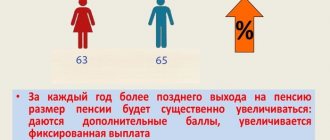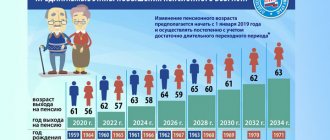Retirement age legally called the number of years determined by the state, after which citizens of the country constitutionally receive the right to regular payments from the budget of the republic, called pension benefits.
Age pensions are financed by the republican budget. The government obliges employers and employees to pay contributions to the Social Security Fund throughout their careers. For hired workers this figure is 1% of their earnings, for managers - 28%.
At the beginning of April 2021, state leader A. Lukashenko signed a decree providing for an increase in the retirement age threshold by 6 months annually from 01/01/2017 to 01/01/2022. It follows that the age for receiving pension benefits will be 63 years for men and 58 for women.
It is important to know that the date of application to the regulatory agency also determines the date of enrollment in government support.
Table of access to Persia in the Republic of Belarus, women
Date of birth Date of retirement Retirement age, years01.01 - 30.06.196201.07 - 31.12.201755.501.07 - 31.12.196201.07 - 31.12.20185601.01 - 30.06.196301.07 - 31.12.201956.5 01.07 - 31.12.196301.07 - 31.12.20205701.01 - 30.06 .196401.07 - 12/31/202157,501.07 - 12/31/1964 and younger 01/07 - 12/31/202258From January 1, Belarus will increase the retirement age and insurance period and introduce changes for families with many children.
From January 1, 2021, the retirement age will increase by six months, as well as the minimum insurance period required to receive a labor pension. This is another planned phased increase. Starting next year, changes will be introduced to pensions for mothers of many children, who may now fall into the “pension trap,” and for people with disabilities. Innovations will also appear for workers with incomplete insurance coverage. TUT.BY tells what pension changes await Belarusians in 2021.
How will the retirement age change?
Let us remind you that the increase in the retirement age began in 2021. Every year he will add six months until he reaches 63 years for men and 58 for women. This will happen in 2022.
In 2021, men retired at 61.5 years old, and women at 56.5 years old. In 2021, the retirement age for men will be 62 years and 6 months, for women - 57 years and 6 months.
In 2022, men will retire at 63 and women at 58.
In 2021, the authorities discussed further raising the retirement age after 2022, but only for women. The IMF also recommended raising the retirement age even further. And this year, Alexander Lukashenko instructed the authorities to evaluate the effectiveness of the pension reform. However, officials have not yet officially spoken about further raising the retirement age.
“Let’s see how the pension reform will affect the balancing of the Fund in 2022,” explained Labor Minister Irina Kostevich.
How will the minimum insurance period change?
In 2021, the minimum insurance period required to receive a labor pension will also be increased. It only includes the time when you worked and the employer paid insurance contributions to the Social Security Fund for you. In 2021, the minimum insurance period is 17.5 years; from January 1, 2021, it will increase by six months to 18 years.
The minimum insurance period increases in the same way as the retirement age: by six months every year until it reaches 20 years (this will happen in 2025). In 2013, the minimum insurance period increased from 5 to 10 years, in 2015 - from 10 to 15, and from 2016 it began to increase every year by six months.
Belarusians who have not completed their insurance period according to the new rules fall into the “pension trap”; they cannot apply for a labor pension, they can only be assigned a social pension: men - from 65 years old, women - from 60 years old. Now the social pension is 129.06 rubles.
Let us remind you that from January 1, 2021, military service in the army began to be included in the insurance period. This innovation was not supported at the discussion stage by the Ministry of Labor and the Ministry of Finance. At the same time, the authorities did not accept changes regarding university studies and maternity leave, the inclusion of which in the insurance period was discussed along with military service.
What will change regarding pensions for mothers of many children?
From January 1, 2021, women who have given birth to four children will have the time spent on parental leave for a total of up to 12 years (currently 9 years) counted into their work experience for purposes of granting a pension. They will be granted labor pensions if they have at least 20 years of work experience and at least 10 years of insurance coverage (currently 17 years 6 months).
Nowadays, mothers with many children who are raising four children run the risk of not achieving the required insurance period, which means they may fall into a “pension trap” - not receiving a labor pension, but only a social one. The fact is that now mothers of three children have maternity leave included in their total length of service in full. For mothers with five or more, additional benefits are provided. But for mothers of four children, only 75% of the entire maternity leave period is included in their total maternity leave period.
This issue has been raised for years. At the same time, the Ministry of Labor opposed allowing mothers of four children to count maternity leave in full toward their total length of service.
– In large families, as a rule, children are born without significant breaks between births. Therefore, the maximum 9-year period can cover the time a mother cares for her fourth, fifth, and even subsequent children,” the Ministry of Labor explained earlier why they do not see the pitfalls of the insurance period for large families.
What will change for people with disabilities
From 2021, disabled people of groups I and II, who have been disabled for more than 10 years, will have their insurance length requirements reduced for an old-age pension (in proportion to the time spent on disability). For people disabled since childhood, the requirements for the length of work experience to obtain the right to an early old-age pension will be reduced by 5 years (for women - from 20 to 15 years, for men - from 25 to 20 years).
In addition, parents of disabled children with severe health impairment who have cared for them for a long time (at least 20 years) will have their social pension increased to the minimum age pension (from 129.06 rubles to 272.57 rubles).
What innovations will be introduced for those who have incomplete insurance coverage?
It is also provided that employees with incomplete insurance experience (more than 10 years, but less than required) will be assigned an old-age labor pension instead of a social pension for incomplete insurance experience. At the same time, women will be assigned such a pension upon reaching 60 years of age, and men - 65 years of age, as is provided for the social pension.
Previously, the Ministry of Labor explained that for 10 years of insurance service, the pension amount will be 73% of the pensioner’s subsistence level budget, or 142.46 rubles today. “The size of the pension will increase by every 3% of this budget for an additional year of insurance coverage exceeding 10,” the department clarified.
Now those who were unable to complete their work experience can apply for a social pension.
Table of access to Persia in the Republic of Belarus, men
Date of birth Date of retirement Retirement age, years01.01 - 30.06.195701.07 - 31.12.201750.501.07 - 31.12.195701.07 - 31.12.20186101.01 - 30.06.195801.07 - 31.12.201961.5 01.07 - 31.12.195801.07 - 31.12.20206201.01 - 30.06 .195901.07 - 12/31/202162,501.07 - 12/31/1959 and younger07/1 - 12/31/202263When is it time to retire?
Born in:
- in the first half of 1962, women and the first half of 1957, men retired at 55.5 and 60.5 years, respectively;
- in the second half of 1962, women and the second half of 1957, men retired at 56 and 61 years old, respectively;
- in the first half of 1963, women and the first half of 1958, men retired at 56.5 and 61.5 years, respectively;
- in the second half of 1963, women and the second half of 1958, men retired at 57 and 62 years old, respectively;
- in the first half of 1964, women and the first half of 1959, men retired at 57.5 and 62.5 years, respectively;
- in the second half of 1964, women and the second half of 1959, men retired at 58 and 63 years old, respectively.
The retirement age has been raised. What do you need to know so as not to be left without money in old age?
January 9, 202016533
From January 1, 2021, the retirement age has increased by another six months. For men it now begins at 62 years old, for women at 57 years old. But this is not the limit. It will “grow” until 2022 inclusive, adding six months every January until it reaches 58 years for women and 63 years for men. In addition, there is a discussion about a possible (after 2022) further increase in the retirement age: either only for women up to 60 years old, or for everyone, up to 65 years old. The fact is that by pushing back the age of retirement, the state, among other things, increases pensions through budget savings.
What do you need to know about insurance experience?
A prerequisite for receiving an old-age pension is the presence of insurance experience . At the moment it is 17.5 years . But it is planned to increase it to 20 years in 2025. Let us remind you that the insurance period is the total duration of all periods of work during which contributions to the Social Protection Fund (SPSF) were paid. Today, this experience does not include: 1. full-time studies in secondary specialized and higher educational institutions 2. military service 3. maternity leave 4. periods of receiving unemployment benefits 5. leave to care for a disabled person (including a child) disabled), a person over 80 years of age. True, military service is promised to be included in the insurance period. But with studies and maternity leave, no changes are expected! On the other hand, for a certain category of citizens of Belarus, the insurance period remains unchanged and amounts to 5 years . These are mothers of many children, disabled children, parents of disabled children. What will happen to a person who falls into the so-called “insurance trap”? Such people can only count on a social pension: women from 60 years old, men from 65 years old. In this case, the pension benefit will be equal to 50% of the subsistence level and will be slightly more than 115 Belarusian rubles.
How to really increase the amount of payments in retirement?
If you want to work for another 5 years after retirement, having completed the necessary documents, but refusing the required pension, you can increase your pension payments in the future. For every 2 months of work under such conditions, your pension will increase by 1% of the earnings accepted for calculation.
Instead of a total
Another way to increase your income in retirement is to open a bank deposit in your youth or adulthood. Deposits with the most favorable conditions can be found here .
Do you want to share your financial experience, give advice on how to properly handle money, express your opinion about banks or organizing a business? Send materials to . We will publish the most interesting ones
Source: www.infobank.by
Retirement age in the world
In addition to the Republic of Belarus, the following states are planning to increase the pension threshold in the near future:
- Russian Federation, where raising the age for both sexes to 65 is being discussed;
- Kazakhstan, whose plans are to equalize the age for women with men (63 years) from 2021;
- the United States of America, where the threshold may increase from 65 to 69 years;
- Estonia, where in 2026 the age will be 65 for everyone.
The reason for the initiation of reforms for the countries of the former Soviet Union is considered to be the demographic crisis of the 1990s, which led to a decrease in the birth rate.
You can quickly learn about this and many other events in the world of money and finance in our groups on Vkontakte, Facebook and Telegram. Join us!
Retirement age in Belarus
Pensions
03.05.2021
45198
Author: Myfin.by editorial staff
Photo: pexels.com
Retirement age is the number of years after which a citizen has the right to receive an old-age pension.
Last news:
The Ministry of Labor reminded why a pensioner may lose his “age-related” additional payment
How to get an increase to your future pension and existing salary: we count with Priorlife
Payers of old-age pensions are pension funds, often state-owned or state-controlled. As a rule, a citizen of working age makes contributions to such funds. In some countries, it is possible to choose a pension system, the amount of contributions to it and other conditions, in some there is only one, state system, the procedure and amount of payments to it are determined by law. The latter fully applies to the Republic of Belarus.
For the first time, old-age pensions and, accordingly, the concept of retirement age appeared in Germany in the 80s of the 19th century. Then it was 70 years old. Due to the fact that at that time the average life expectancy was significantly less than 70 years, the payment of pensions was not too burdensome for the state budget, but the very existence of such a law created a sense of security and trust in the state among the population.
Over time, other European countries, the USA, and the USSR began to pay old-age pensions. Currently, citizens of most countries in the world can apply for an old-age pension.
The initial and main purpose of granting an old-age pension was to provide a means of subsistence for persons who were unable to work due to old age.
It should be noted, however, that the retirement age limit is nowhere determined individually based on the working capacity of a particular person.
Over time, a different interpretation of the old-age pension has appeared, more related to the concept of well-deserved rest: provided that a person engages in socially useful work and pays contributions to pension funds, upon reaching a certain age, he has the right to receive pension payments from these funds.
Both concepts are currently in use. In practice, this leads to the fact that any citizen has the right to an old-age pension, even if he was not engaged in any useful activity, but for those who worked and made pension contributions, the size of pensions is significantly higher.
The retirement age in most countries is 60-65 years. As a rule, it was appointed simultaneously with the advent of old-age pensions and, in general, was close to the age of actual loss of ability to work at the time of the formation of the pension system. Then the retirement age could be reduced under pressure from trade unions, socialist and human rights movements.
Over time, in parallel with the increase in life expectancy and improvement in the health of the population, in economically and socially prosperous countries a situation developed in which the majority of those retiring were in a fully working condition both in health and in professional skills. Coupled with a decline in the birth rate in these same states, this situation led to noticeable socio-economic imbalances. Regardless of the principles of the pension system, the financial support of pensioners falls on the shoulders of working groups of the population, but their number has fallen, and the number of pensioners has grown.
Understanding this fact marked the beginning of discussions about raising the retirement age.
Their essence can be traced to the contradiction between the desire for social well-being and social responsibility.
At the moment, there is a need to economically balance the ratio of the working population and pensioners. Otherwise, society will have to increase pension contributions for workers and reduce the average size of pensions, which may be unacceptable for both parties.
In the future, there is already a tendency to bring the retirement age to some acceptable balance between the real age of loss of ability to work and the age of retirement. There is also an increasing refusal to lower the pension threshold for women, who usually exceed men in terms of life expectancy and age at which they lose their ability to work.
This is the general situation in most economically and industrially developed countries.
For more information, we present a table with data on the retirement age according to data from 2008-2017.
| A country | Men | Women |
| Germany | 65-67 | 65-67 |
| Denmark | 65-67 | 65-67 |
| Poland | 65-67 | 60-67 |
| Ireland | 65-66 | 65-66 |
| Finland | 62-68 | 62-68 |
| Sweden | 61-67 | 61-67 |
| Greece | 58-65 | 58-65 |
| Italy | 57-65 | 57-65 |
| Iceland | 67 | 67 |
| Norway | 67 | 67 |
| Austria | 65 | 60 |
| Belgium | 65 | 65 |
| Bosnia and Herzegovina | 65 | 65 |
| Great Britain | 65 | 65 |
| Georgia | 65 | 60 |
| Spain | 65 | 65 |
| Canada | 65 | 65 |
| Cyprus | 65 | 65 |
| Kosovo | 65 | 65 |
| Latvia | 65 | 65 |
| Luxembourg | 65 | 65 |
| Netherlands | 65 | 65 |
| Portugal | 65 | 65 |
| USA | 65 | 65 |
| Croatia | 65 | 60 |
| Chile | 65 | 60 |
| Switzerland | 65 | 64 |
| Japan | 65 | 65 |
| Albania | 65 | 60 |
| Liechtenstein | 64 | 64 |
| Macedonia | 64 | 62 |
| Montenegro | 64 | 59 |
| Armenia | 63 | 63 |
| Bulgaria | 63 | 60 |
| Kazakhstan | 63 | 58 |
| Kyrgyzstan | 63 | 58 |
| Romania | 63 | 58 |
| Serbia | 63 | 58 |
| Slovenia | 63 | 61 |
| Tajikistan | 63 | 58 |
| Estonia | 63 | 61 |
| Azerbaijan | 63 | 58 |
| Lithuania | 63 | 60 |
| Hungary | 62 | 62 |
| Moldova | 62 | 57 |
| Slovakia | 62 | 55-59 |
| Turkmenistan | 62 | 57 |
| Czech | 61 years 10 months | 56-60 |
| Malta | 61 | 60 |
| Belarus | 60 (by 2022: 63) | 55 (by 2022: 58) |
| Russia | 60 | 55 |
| China | 60 | 50-55 |
| Uzbekistan | 60 | 55 |
| Ukraine | 60 | 55 |
| France | 60 | 60 |
It is worth adding that in China there is still no universal pension system; a limited number of people receive pensions. Providing for the elderly is the responsibility of their children, other relatives or the community.
Many states are planning to increase the retirement age in the near future, as follows:
- Ukraine intends to gradually raise the retirement age for women to 60 by 2021;
- Kazakhstan plans to equalize the retirement age for women with that for men (63 years old) from 2021;
- Poland and the UK plan to raise the retirement age for both sexes to 67;
- Russia is actively discussing a similar increase to age 65;
- In the United States, the issue of raising the retirement age from 65 to 69 is being discussed;
- In France, it is possible to increase the pension threshold to 62 years.
The Republic of Belarus inherited from the Soviet Union a pension system and, in particular, a retirement age of 60-55 years for men and women, respectively. However, since 2017, a pension reform has been carried out in Belarus, which provides for an increase in the retirement age.
In the USSR, old-age pensions appeared back in 1932. At the same time, the retirement age was set at 60 years for men and 55 for women. It is worth remembering that the average life expectancy during this period was approximately 45 years, so the payment of pensions was not a burden on the state.
Today, the average life expectancy in Belarus is 70.2 years (64.3 for men; 76.1 for women). This clearly falls short of 78-81 in prosperous European countries, but our labor productivity is noticeably lower.
An aging population has become a reality for the Republic.
According to the 2009 population census, the ratio of citizens who named work as their main source of income was exactly twice the number of people living on pensions. Data on the ratio of the number of workers and pensioners differ in different sources, but everyone agrees that the number of workers is clearly insufficient to support the growing number of pensioners. To maintain the sustainability of the economy, there must be at least four workers for every pensioner.
Despite the not very good state of health of people of pre-retirement age in Belarus, there is still some “health reserve”. Thus, approximately a quarter of old-age pension recipients continue to work for some time, and probably the same number would like to remain in their jobs if possible. However, the idea of increasing the pension threshold is not popular; those expecting pensions in the coming years are especially nervous about such plans.
Perhaps for this reason, raising the retirement age was not planned in the Republic of Belarus. The President spoke directly about this and other officials stated.
On the other hand, the most optimistic forecasts do not promise a way out of the current demographic impasse. Even in the case of a sharp increase in the birth rate, a positive economic effect will have to wait at least 20-30 years. There is also no dramatic increase in productivity. And the population continues to age...
However, based on the decree of April 11, 2021 “On improving pension provision,” pension reform will be put into effect from 2021 to 2022. Every year from January 1, 2021, the minimum age for obtaining a labor pension will increase by 6 months and by the beginning of 2022 it will be 58 years for females and 63 for males. In accordance with the decree of December 31, 2015, the minimum insurance period required to apply for an old-age pension will increase annually by the same six months (for 2021 it is 18 years, and by 2025 it will reach 20).









